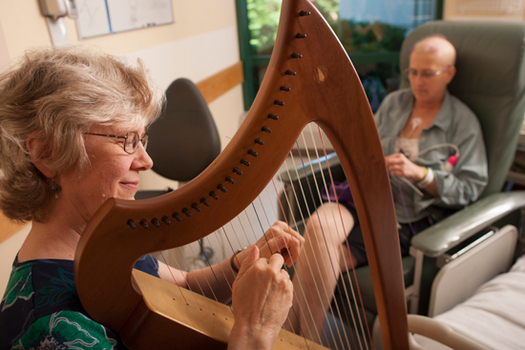The Artists' Way
/Originally published in Dartmouth-Hitchcock's CenterView, this is Part 1 of a three-part series on the Creative Arts Program.)
The anxious patient was from Jordan and didn’t speak much English. But a nurse had asked therapeutic harpist Margaret Stephens to come to her room—and when Stephens began to play the Beethoven and Mozart she requested, she sat up in bed and leaned close.
“I was concerned that something was wrong and then realized she was moving closer to the harp,” Stephens said. “She was very obviously involved in listening. ... A relative translated that she was imagining being out in a field and involved with nature. She really enjoyed the music and thanked me for coming. The family said they could see a change on her face.”
That patient’s reaction is not uncommon as Stephens goes about the hospital, visiting patients and playing in waiting areas. She’s part of Dartmouth-Hitchcock’s Creative Arts Program, which brings music, art and writing to patients and families.
The program got its start at the Koop Institute as a collaboration between medical students and inpatients. It brought in visual artist Kathy Parsonnet; Rebecca Gottesman is now the program’s artist in residence. The program expanded to include writer Marv Klassen-Landis and Stephens.
Having artists interact with patients is more than a way to channel stress and anxiety, bring catharsis and offer diversions, said Elisabeth Gordon of DHMC’s Arts Program, which oversees Creative Arts. “Studies show that engaging in uplifting visual art, music and literature can slow a person’s heart rate, lower their blood pressure, decrease their need for pain medication, and lower their stress level.”
“Music often helps family and patients release emotions or provide a comforting background sound when people are at a loss for words,” she said. “Sometimes I work with children who are in the waiting area and let them have a chance to experience the harp and pick out a tune.”
The important thing about engaging in the arts is not the finished product, says Gordon; it’s the process itself that matters.
“All of our artists are knowledgeable about working with patients who are in isolation, immobile, or limited in other ways,” Gordon said. “Someone too weak to write may enjoy being read to. Hearing uplifting poems written by other patients is a favorite request. We have had patients who were unable to speak write lyrics with the help of a computer, or a blind patient engage in art making. Each artist can usually adapt their work to accommodate the patient so that virtually anyone can benefit from engaging with them.
“The act of creating is in these cases is more important than the results. The act of engagement can give a person a sense that they are larger than their disease and a unique being with much to offer.”
Read more about a study of harp music’s effect on ICU patients (Huffington Post)
The Creative Arts Program is a collaboration with the Cancer Center’s Patient and Family Support Services Department, and works closely with Palliative Care.
To learn more about Creative Arts or to request that an artist visit your department, call (603) 653-7751. To request harpist Margaret Stephens, contact Deb Steele in Patient and Family Support Services.

